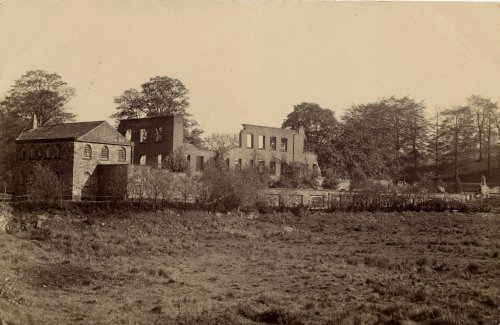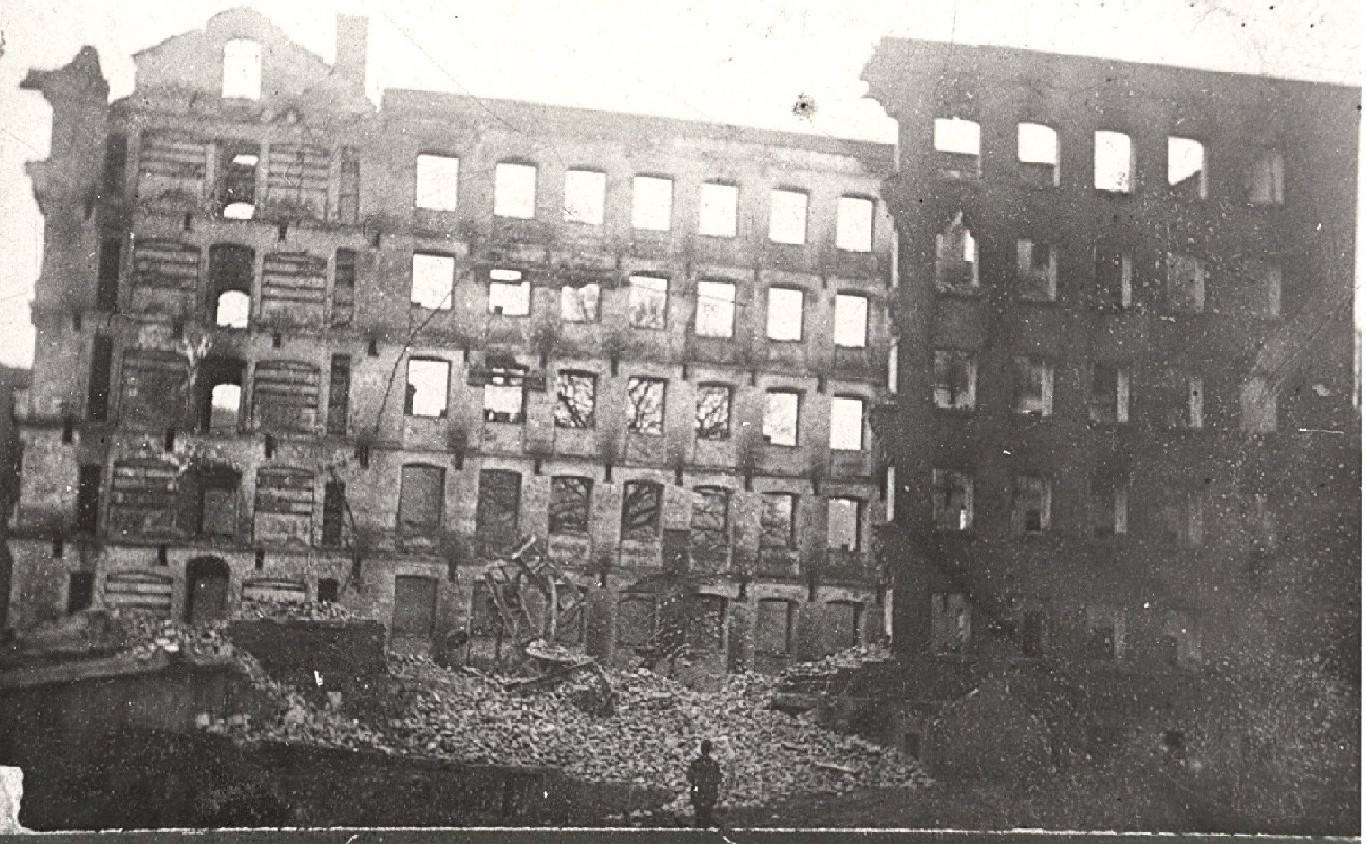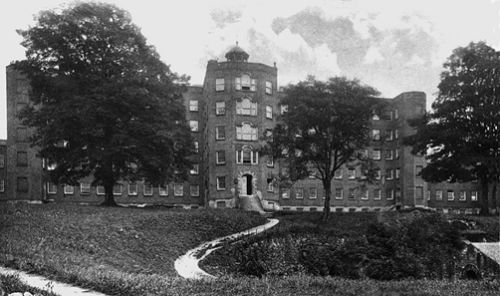Newspaper article from Cheshire County News 19th November 1892.
Great Mill Fire, Marple : A Gigantic Blaze. The Building Completely Gutted. A dismal Outlook for the Villagers.
 Mill post-fire, rear view (Corn mill on left)
Mill post-fire, rear view (Corn mill on left)
Early on Thursday morning a most destructive fire broke out in the Mellor Mill, Marple by which in about two hours the main structure was entirely destroyed. Spinning and doubling were carried on at the mill, which afforded employment for about 200 workpeople.
The premises were six storeys high with side wings filled with new machinery which was only partially insured. The mill was built in 1790 and was of historic interest. Shortly after two o?clock in the morning a cottager who resides in close proximity to the mill noticed from her bedroom window flames issuing from the centre of the factory. She immediately ran to the village and raised the alarm. The shouts of "Fire" were soon resounding throughout the whole neighbourhood, and an hour later there was a general stampede of the villagers en route for the scene of the conflagration. On their arrival at the mill a sight, terrible in its magnificence, met their view.
A dense fog enveloped the whole district, and it was only at the distance of a few hundred yards and the lurid glare penetrated the dense atmosphere. All was excitement, and it was palpable that the premises could not be saved, the flames having by this time obtained a complete mastery of the building. Immense tongues of fire were belching forth from the windows. Higher and higher they leaped and blazed, the building and its environs being encircled with a halo of crimson light. Still the fire fiend raged unchecked. A message was despatched to Marple and Compstall fire brigade, but they arrived too late to be of any practical service. The spectacle when the fire was at its height was a splendid but awe inspiring one. The entire mass of building, which cover half an acre in area was one gigantic blaze, brilliantly illuminating the district huge columns of smoke ascended into the heavens and hung in the form of a dense canopy over the burning building. One by one the machinery clanged together like the roar of artillery. Then the roof with one gigantic swoop collapsed, falling through the practically demolished building with a thunderous smash, amidst the shrieks of the bystanders, for all the village was now awake. The mill girls with their shawls over their heads, the children clinging, terrified to their mothers dresses, and men who had been striving to render what little assistance their was in their power, were all eagerly gazing at the burning pile.
 Mill post-fire, front view
Mill post-fire, front view
These efforts of the men were, however, of little use. Two engines were now in attendance and a number of box pipes were got to work, a splendid supply of water being at hand, but the puny liquid sprays did not in the slightest degree abate the fury of the fierce fire. Still the men continued to work like galley slaves, evidently with the determination that no effort on their part should be wanting to minimise the loss which inevitably ensued. They worked with pertinacity and indomitable perseverance which was most praiseworthy, but within a few hours from the detection of the fire Mellor Mill was a complete wreck. At eight o'clock on Thursday morning nothing remained of the magnificent pile of buildings but the towering walls, standing gaunt and bare. Numberless bundles of cotton in its woolly state were smouldering slowly away, making the air unpleasant with their sickly odour. Scores of willing hands, when the flames had almost died out, were busily engaged in carrying away those bundles which had not been entirely destroyed, to separate the burning from the uninjured material. Fortunately, the yarn cellar was not reached by the fire, and it is believed that about 750 bundles are saved. This however, is nothing comparatively to the immense damage that has been wrought.
Page 2
The greatest mystery of all is how the conflagration originated. On this point all - managers, overlookers, and workmen alike - are in the dark, and no possible clue seems forthcoming to elucidate the point. The extant of the damage is immense and will doubtless reach five figures. This, however, is only an approximate estimate, as it is too early to form anything like an accurate judgment. Only recently, however, the firm (Messrs. John Clayton and Co., Limited), by whom the mill is owned, had £2,000 worth of new machinery put into the mill, and they will, of course, by the fire and water and breakages, be rendered practically useless. The mill which as previously stated is over a century old, must have been splendidly built. Only one slight breach has been made in the walls. It has been constructed on a stone foundation, and is striking contrast, both in architecture and workmanship, to present-day erections. Doubtless had not the night been so foggy the damage would have been much less, as the flames would have been observable at a much greater distance and assistance more easily procured. Sergeant Gee, the local police officer, only went off duty about the time of the outbreak and under ordinary circumstances the fire could have been seen from his residence. As it was the flames had got a complete hold of the building before they were discovered. But by far the most serious aspect of the case is the utter breakdown of what is the only industry in the neighbourhood. There is, in addition, Mr Jowett's cotton wadding mill, but this only finds employment for about 30 hands. It will thus be seen that the
Mellor Mill in its prime
destruction of the mill is not only a serious blow to the shareholders but to the workpeople as well. The latter have a gloomy prospect before them for this winter, as practically the whole of the breadwinners of Mellor, and a considerable portion of the residents of Marple, will be thrown out of employment under any circumstances - even if it was decided to rebuild the mill - it will take a considerable time to reconstruct it. A contractor examined the walls of the mill this morning, and although they are standing perfectly erect now he gave it as his opinion that they might collapse at any moment. The village of Marple, with its picturesque sylvan surroundings, is likely to be a desolate place, at least to the villagers, this winter. When our reporter left the building this morning some of the beams were still burning slowly away. Not a breath of air stirred to fan the dying embers. The excitement had almost abated. Groups of villagers were to be seen in agitated converse. Others, on the contrary, were blithe and gay, and apparently did not take things so seriously. All, more or less, seemed to be depressed with the catastrophe which had befallen them. The mill is beautifully situated on the top of a gradually rising eminence from the village, bordering on the banks of Derbyshire side of the river Goyt, which at this part of its career pursues its course along an unnavigable bed. Nearer the village there is a pretty little waterfall, splashing musically as the water smoothly glides over the rocks. The surroundings are strikingly emblematic of rural England. The building is quite isolated, and so there was no possibility of the flames spreading beyond the limits of the mill - a fortunate circumstance. During the morning a number of visitors surveyed the demolished fabric with interest.
Researched by Ann Hearle
Compiled by Louise Thistleton
Newspaper article from the Derbyshire Advertiser Friday 18th November 1892
SERIOUS FIRE AT MELLOR MILL
THE BUILDING GUTTED
200 Hands Thrown Out of Employment
A serious outbreak of fire occurred shortly after Midnight on Wednesday at Mellor doubling and spinning mills. The building, which was erected in 1790, is of historic interest, being one of the oldest mills in the district. It was six storeys high, with wings where new machinery has been recently fitted. As the floors were dry or well saturated with oil the flames spread with great rapidity, and in about two hours’ time the structure was entirely destroyed by the fire. As the damage is only partially covered by Insurance, it is feared that a loss will be incurred. The villagers will, however, be the greatest sufferers by the fire, as the mill found employment for 200 hands, who will now be thrown out of work at the commencement of the inter season.
Another account says:- Quite a little calamity occurred in the destruction by the fire of the Historical Mellor Mill, better known as Oldknow’s, built in the tear 1790 by Mr Samuel Oldknow, to whose memory there is a medallion tablet in the old All Saints Church, Marple. The fire began at half-past two, and though the fire engines from Marple and Compstall were quickly on the scene, and there was also water in the mill, the main building of six stories high and twenty windows long, was completely gutted: nothing but bare walls were left standing. The left wing was partially destroyed. The mill was formerly filled with old=fashioned machinery, but this has been lately substituted by modern spinning and doubling machinery. The building was partially insured and employed about 200 workers. It was a limited concern. The mill was partly driven by steam and partially by water power. Three large water-wheels (formerly the main driving power), are place, two under the mill, and one in a room constructed purposely for it in a hollow near the mill yard. The loss by fire will be several thousands of pounds.
Glossop Chronicle : November 1892. Mellor Mill burnt down. 200 employed. Mill, engaged in cotton spinning and doubling, only partially insured. Built by Samuel Oldknow in 1790, and a wing added in 1815. For years driven by water paper arranged in marvellous manner.
Notes:
After the fire substantial portions of the mill remained standing ,for a number of years, these included some of the smaller buildings on the bank of the River Goyt. In the 1920’s papers were found, in the surviving counting house, relating to Oldknow’s business affairs. Eventually the Mill brickwork broke down into clay, leaf mould into soil, and trees grew, and grew as time passed until the Mellor Archaeological Trust came along, with the novel idea of emptying the Wellington Wheel Pit, largest in the world at the time, two floors below ground level in the Mill.
To learn what has happened then, and since then, visit the Trust's website.
The Trust homepage section on Mellor Mill is at ......
http://www.matrust.org.uk/mellor-mill-1792-1892.html
On Google books Samuel Oldknow and the Arkwrights: The Industrial Revolution at Stockport and Marple click on 'Preview this book' on the webpage to read inside.
An Archaeological Evaluation of Samuel Oldknow’s Mellor Mill, The Roman Lakes,Marple Bridge, Stockport a pdf file available here...
http://www.mellorheritage.org.uk/pdf-reports/2009-report-Mellor-Mill-excavations.pdf
You may also like to see details of the talk given to the Society in December 2012 on the Wellington Wheel Pit and the Mill by Bob Humphrey-Taylor, to be found here.

